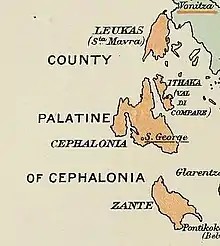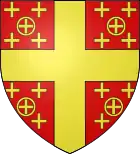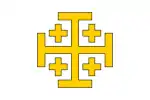County Palatine of Cephalonia and Zakynthos
The County Palatine of Cephalonia and Zakynthos existed from 1185 to 1479 as part of the Kingdom of Sicily. The title and the right to rule the Ionian islands of Cephalonia and Zakynthos was originally given to Margaritus of Brindisi for his services to William II, King of Sicily, in 1185.[1]
| County Palatine of Cephalonia and Zakynthos Παλατινή Κομητεία της Κεφαλονιάς και της Ζακύνθου | |||||||||||
|---|---|---|---|---|---|---|---|---|---|---|---|
| Vassal state* of various countries, de facto autonomous | |||||||||||
| 1185–1479 | |||||||||||
 County Palatine of Cephalonia and Zakynthos | |||||||||||
| Capital | Castle of Saint George | ||||||||||
| Government | |||||||||||
| • Type | County palatine | ||||||||||
| Count palatine | |||||||||||
• 1185–1195 | Margaritus of Brindisi | ||||||||||
• 1448–1479 | Leonardo III Tocco | ||||||||||
| Historical era | Middle Ages | ||||||||||
• Established | 1185 | ||||||||||
| 1479 | |||||||||||
| |||||||||||
| Today part of | |||||||||||
Following Margaritus, the county passed on to a branch of the Orsini family until 1325, when it passed briefly to Angevins and then, from 1357, to the Tocco family. The Tocco used the county as a springboard for their acquisition of lands in the Greek mainland, and were successful in gaining control over the Despotate of Epirus in 1411. However, facing the advance of the Ottoman Turks they successively lost their mainland territories and were once again reduced to the County Palatine, which they held until 1479, when it was divided between Venice and the Ottomans. Zakynthos was put under the direct rule of Venice.
History
The beginning of the Frankish conquest in the islands of Cephalonia, Zakynthos and Ithaca was linked with the pirate and admiral of the Sicilian fleet Margaritus of Brindisi, known to the chroniclers of the late 12th century. He developed significant activity as the trustee of William II, Norman King of Sicily. In Latin documents of 1192 and 1193, he signed in Greek as Margaritoni Admiral Count Melitios. Irrespective of Margaritus’ unclear descent, it is certain that William, after the Norman invasion of 1185 against the Byzantine provinces, granted him the new Norman acquisitions in the Ionian Sea, in exchange for the services he had offered to the Normans.
Ten years later, in 1195, Maio or Matthew Orsini, possibly an offspring of a Sicilian branch of the family of the Palatine Counts of Rome, succeeded Margaritus as the ruler of the Ionian Islands. In order to secure his position, Matthew recognized the dominion of Venice and of the Pope and later of the Prince of Achaea. During that same period the Orthodox bishopric of the islands was abolished, the Episcopal thrones were occupied by Latins and the feudal system was put into force. The successor of Matthew, Richard, the "most noble count of the palace and lord of Cephalonia, Zakynthos and Ithaca", authenticated in 1264 the estates of the Latin bishopric of Cephalonia. During the reign of the latter Frankish ruler, Cephalonia had become a refuge for pirates.
The Orsini family did not only rule the Ionian Islands but also conquered Epirus in early 14th century, thus acquiring the title of 'the despot' as well. Certain members of the family embraced the Orthodox dogma and married Greek women. After the death of John II Orsini in 1335, the islands were occupied by the Anjou, who, as rulers of Achaea, had the islands under their suzerainty until then.
The Angevin occupation lasted until 1357, when the said Greek territory was ceded to the Italian family of the Tocchi, who remained in power for over a century and secured unity in the governance of those three Ionian Islands. In 1357, Robert of Taranto ceded Cephalonia, Zakynthos and Ithaca to the governor of Corfu, Leonardo I Tocco, as reward for the services he had provided when he was a captive of the King of Hungary.
After the expansion of his dominion to Leukas, Leonardo I Tocco attempted to reinforce his position against Venice, the pope, and the Anjou, but mostly against the Albanians of Epirus, by entering into family relations with the Florentine family of the Acciaiuoli.
This policy gave the family of the Tocchi increased power, which reached its peak during the 15th century with its expansion to the continental coast, after Carlo I Tocco conquered Ioannina (1411) and Arta (1416). He received the title of despot by the Byzantine emperor Manuel II Palaiologos and maintained the Byzantine tradition. Seated in the islands of the Ionian Sea or in the acquisitions in Central Greece, the dynasty of the Tocchi attempted to win over the populations by ceding to the seigneurs, according to the Chronicle of the Tocco, "inheritances", "estates", "kratimata" and "pronoias". An example of this is the family Galati, who received privileges and estates from the Tocco on the island of Ithaca. Following an analogous policy on the religious front, Leonardo III (1448–1481), the last of the Tocchi dynasty, reinstated the Orthodox episcopal throne of Cephalonia that had been abolished by the Orsini.
Venice was not pleased with the increased influence of the Tocchi. The downfall of the duchy of the Tocchi by the Turks (1479) gave the opportunity to the Serenissima to intervene resolutely in the Ionian Sea and succeeded, through the treaty of 1484, in annexing Zakynthos and, in 1500, Cephalonia and Ithaca.
Counts Palatine of Cephalonia and Zakynthos
Orsini family
- Matthew Orsini, 1195 – after 1238
- Richard Orsini, before 1260 – 1304
- John I Orsini, 1304–1317
- Nicholas Orsini, 1317–1323
- John II Orsini, 1323–1325
Angevins
- John of Gravina, 1325–1336
- Robert of Taranto, 1336–1357
House of Tocco
- Leonardo I Tocco, 1357–1376
- Charles I Tocco, 1376–1429
- Charles II Tocco, 1429–1448
- Leonardo III Tocco, 1448–1479
References
- "GNTO-Greek Islands-Zakynthos-Historic Facts". www.hri.org. Retrieved 2017-05-23.
Sources
- Fine, John Van Antwerp (1994) [1987]. The Late Medieval Balkans: A Critical Survey from the Late Twelfth Century to the Ottoman Conquest. Ann Arbor, Michigan: University of Michigan Press. ISBN 0-472-08260-4.
- Nicol, Donald M. (1984) [1957]. The Despotate of Epiros 1267-1479: A Contribution to the History of Greece in the Middle Ages (2. expanded ed.). Cambridge University Press.
- Nicol, Donald M. (1993). The Last Centuries of Byzantium, 1261–1453 (Second ed.). Cambridge: Cambridge University Press. ISBN 978-0-521-43991-6.
- Zečević, Nada (2014). The Tocco of the Greek Realm: Nobility, Power and Migration in Latin Greece (14th-15th centuries). Belgrade: Makart.


